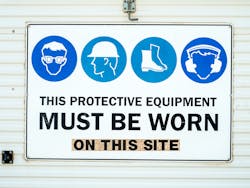At a Tennessee appliance plant, the plant engineer noticed he was raising his voice considerably to have a conversation with the maintenance manager while standing near a particular production line. Looking around, he saw no sign posted requiring hearing protection.
What do you think he did? What do you think the maintenance manager did in response to seeing that “look around”? What would you do? Without saying a word about it, both men began to roll up the foam earplugs they carried with them.
There wasn’t a hearing protection sign in that area because at the time the signs were posted, the area had a different configuration. It wasn’t nearly as loud, then. But things change.
If there is a sign telling you to wear hearing protection or eye protection, then you should wear that protection. If you believe the sign is outdated, make a suggestion to the safety director. If the conditions are such that there should be a sign but there isn’t one, you have a choice. You can choose to use lack of a sign as an excuse to put yourself in danger. Or you can choose to make your own PPE decisions based on your training, experience, and desire to be safe.
The first choice assumes there is truth to this position: “No sign tells me to wear it, so there’s no reason to do so.” That position is based on the false assumption that signage, not conditions, dictate how you should protect your precious hearing and eyesight.
It is the conditions that can cause you to lose these gifts. So it is the conditions that inform your choice.
This is a good principle to keep in mind generally. As you approach an area where a lift truck driver is moving pallets, do you really need someone to tell you to take a different path and avoid the area? If you see a spill but there’s no sign or barrier blocking you from walking across it, do you walk around it anyhow? Continually assessing the conditions around you and responding intelligently to the safety threats you discover is a good habit to develop.
About the Author

Mark Lamendola
Mark is an expert in maintenance management, having racked up an impressive track record during his time working in the field. He also has extensive knowledge of, and practical expertise with, the National Electrical Code (NEC). Through his consulting business, he provides articles and training materials on electrical topics, specializing in making difficult subjects easy to understand and focusing on the practical aspects of electrical work.
Prior to starting his own business, Mark served as the Technical Editor on EC&M for six years, worked three years in nuclear maintenance, six years as a contract project engineer/project manager, three years as a systems engineer, and three years in plant maintenance management.
Mark earned an AAS degree from Rock Valley College, a BSEET from Columbia Pacific University, and an MBA from Lake Erie College. He’s also completed several related certifications over the years and even was formerly licensed as a Master Electrician. He is a Senior Member of the IEEE and past Chairman of the Kansas City Chapters of both the IEEE and the IEEE Computer Society. Mark also served as the program director for, a board member of, and webmaster of, the Midwest Chapter of the 7x24 Exchange. He has also held memberships with the following organizations: NETA, NFPA, International Association of Webmasters, and Institute of Certified Professional Managers.
